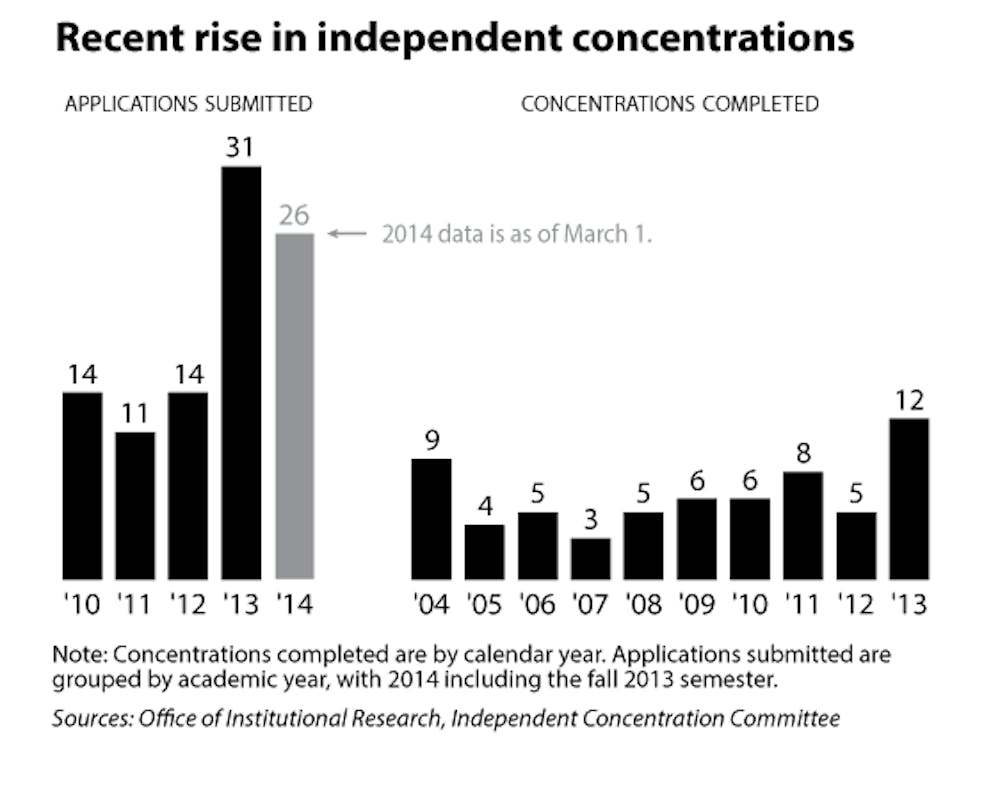As sophomores scramble to declare their concentrations ahead of tomorrow’s deadline, increasing numbers of students are opting to design their own.
The number of independent concentration applications filed has spiked in recent years — in the 2012-2013 academic year, 31 independent concentration applications were filed, rising from 14 the year before. As of March 1, 26 applications have been filed this year, according to numbers provided by the Independent Concentration Committee. The number is projected to match last year’s total by the end of this cycle, said Besenia Rodriguez, associate dean of the College for research and upperclass studies and member of the Independent Concentration Committee.
Rodriguez said this rise is partly due to the increase in peer coordinators in the Curricular Resource Center and efforts to increase awareness about the program. This year marks the third year there have been two student Independent Concentration Coordinators, up from one in previous years, Rodriguez said.
“Having this sort of energy from students who have been through the process but who also do sit in on the committee meetings and understand the process intimately from the committee’s view is really, really helpful in some ways in demystifying the process,” Rodriguez said.
Alexandra Urban ’15, one of the Independent Concentration Coordinators and a Herald staff photographer, said she, fellow student coordinator Alice Preminger ’14, Rodriguez and Curricular Resource Center Director Peggy Chang “are really focused on getting the word out to a broader group of people.” For example, in hopes of makind information more accessible, they put more details on the CRC website, Urban said.
The CRC website provides resources for those interested in applying for independent concentrations, including approved concentrations, capstone projects and course lists from past independent concentrators, she said.
Rodriguez said the number of independent concentration applications reached its peak in the 1970s, which she attributed partly to the fact that the number of standard concentration options has increased over the years.
Lauren Galvan ’16, whose independent concentration in mental health and healing was recently approved, said the deans on the Independent Concentration Committee and Urban were valuable resources during the application process.
The goal is not necessarily to boost the volume of applications filed but to spread awareness of the opportunity, Urban said. “We have heard from juniors (who say), ‘Oh, I wish I had heard about it earlier,’ and that’s the situation we’re trying to avoid, as opposed to increasing the numbers,” she said.
Bianca Camacho ’16, who is currently applying for an independent concentration in neuroeducation, said she knows many first-years interested in exploring the option. “I don’t know if it’s because they’ve heard about it more or because they have new ideas that they can’t pursue from any other concentrations offered here.”
As the program has grown, independent concentrations have become more structured and have more formal advising, Rodriguez said.
Wendy Klein ’79, who pursued an independent concentration in psycholinguistics and cognition, told The Herald the reason she wanted to attend Brown was because “it gave each of us so much control over our educational direction.”
At the time, there was no cognitive science concentration, so she decided to build her own. Klein, who now teaches writing and production at Berklee College of Music, uses the research and information she gained from her independent concentration to approach her teaching, she said.
Klein said she recalls less rigorous guidelines when she was applying for her independent concentration.
“In the ’70s, we were a little bit more relaxed about our education, and I feel like the independent concentration had fewer hurdles to go through,” she said.
Galvan said one challenging part of the application was making sure she had the right balance of interdisciplinary and narrowly targeted coursework. “If I (went) too interdisciplinary and (didn’t) have a very cohesive theme, then I wouldn’t get accepted.”
Finding an adviser also proved difficult, said Galvan, who contacted more than 30 professors before one finally agreed.
Danyul Cho ’89, who graduated with an independent concentration in architectural studies, said he “explored different established concentrations but came to the conclusion I would best be served by doing my own concentration.” Being an independent concentrator “requires a mindset that basically you’re in charge of your own education,” which helped prepare him for his future in graduate school and his current profession, he said.
Cho said when he was at Brown, he felt on his own academically and did not “remember doing anything with other independent concentrators until basically graduation.”
Urban said the Independent Concentration program currently aims to make students “feel like they have more of a community,” citing an increased number of Independent Concentration Departmental Undergraduate Group events, including a Degree Day in March, at which Klein and Cho spoke.
The program “seems like it has grown by leaps and bounds,” Cho told The Herald, adding that students now are pursuing “more and more interdisciplinary” topics.

ADVERTISEMENT




